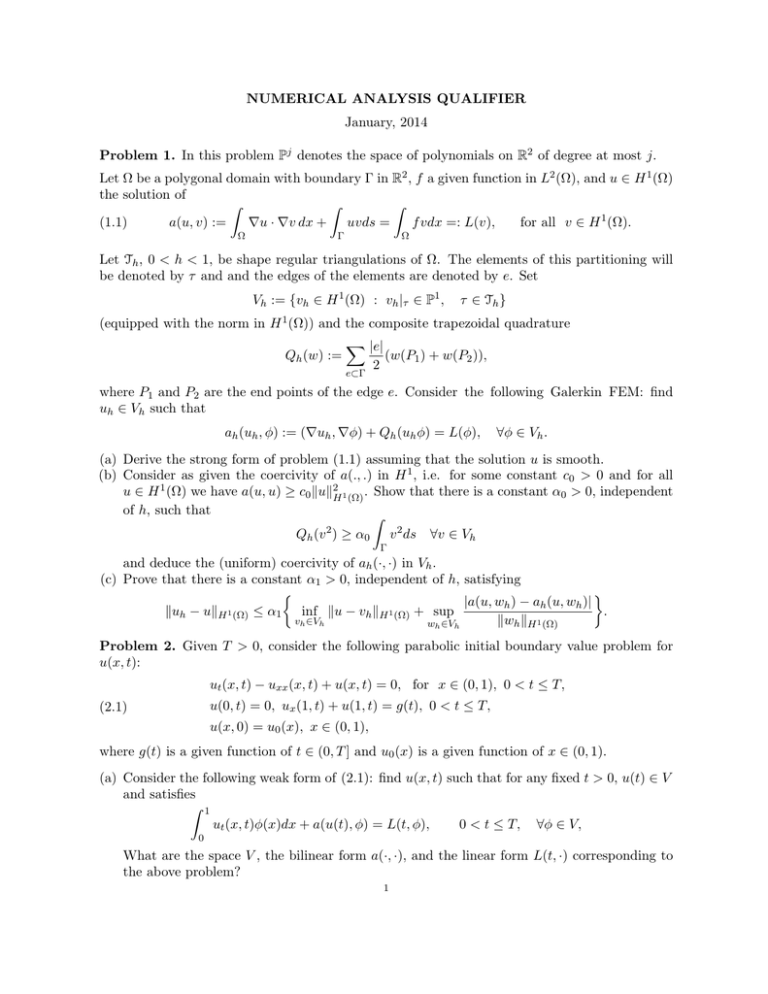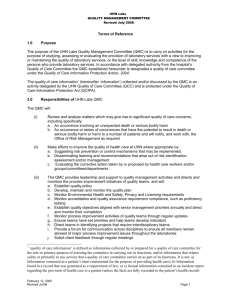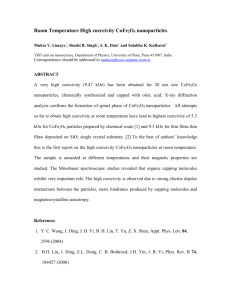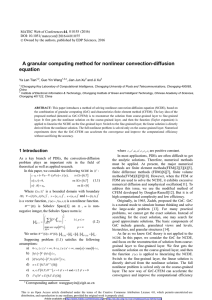NUMERICAL ANALYSIS QUALIFIER January, 2014 Problem 1. In this problem P
advertisement

NUMERICAL ANALYSIS QUALIFIER
January, 2014
Problem 1. In this problem Pj denotes the space of polynomials on R2 of degree at most j.
Let Ω be a polygonal domain with boundary Γ in R2 , f a given function in L2 (Ω), and u ∈ H 1 (Ω)
the solution of
Z
Z
Z
f vdx =: L(v),
for all v ∈ H 1 (Ω).
∇u · ∇v dx + uvds =
(1.1)
a(u, v) :=
Ω
Ω
Γ
Let Th , 0 < h < 1, be shape regular triangulations of Ω. The elements of this partitioning will
be denoted by τ and and the edges of the elements are denoted by e. Set
Vh := {vh ∈ H 1 (Ω) : vh |τ ∈ P1 ,
τ ∈ Th }
(equipped with the norm in H 1 (Ω)) and the composite trapezoidal quadrature
X |e|
Qh (w) :=
(w(P1 ) + w(P2 )),
2
e⊂Γ
where P1 and P2 are the end points of the edge e. Consider the following Galerkin FEM: find
uh ∈ Vh such that
ah (uh , φ) := (∇uh , ∇φ) + Qh (uh φ) = L(φ),
∀φ ∈ Vh .
(a) Derive the strong form of problem (1.1) assuming that the solution u is smooth.
(b) Consider as given the coercivity of a(., .) in H 1 , i.e. for some constant c0 > 0 and for all
u ∈ H 1 (Ω) we have a(u, u) ≥ c0 kuk2H 1 (Ω) . Show that there is a constant α0 > 0, independent
of h, such that
Z
Qh (v 2 ) ≥ α0
v 2 ds
∀v ∈ Vh
Γ
and deduce the (uniform) coercivity of ah (·, ·) in Vh .
(c) Prove that there is a constant α1 > 0, independent of h, satisfying
|a(u, wh ) − ah (u, wh )|
kuh − ukH 1 (Ω) ≤ α1 inf ku − vh kH 1 (Ω) + sup
.
vh ∈Vh
kwh kH 1 (Ω)
wh ∈Vh
Problem 2. Given T > 0, consider the following parabolic initial boundary value problem for
u(x, t):
ut (x, t) − uxx (x, t) + u(x, t) = 0, for x ∈ (0, 1), 0 < t ≤ T,
u(0, t) = 0, ux (1, t) + u(1, t) = g(t), 0 < t ≤ T,
(2.1)
u(x, 0) = u0 (x), x ∈ (0, 1),
where g(t) is a given function of t ∈ (0, T ] and u0 (x) is a given function of x ∈ (0, 1).
(a) Consider the following weak form of (2.1): find u(x, t) such that for any fixed t > 0, u(t) ∈ V
and satisfies
Z 1
ut (x, t)φ(x)dx + a(u(t), φ) = L(t, φ),
0 < t ≤ T, ∀φ ∈ V,
0
What are the space V , the bilinear form a(·, ·), and the linear form L(t, ·) corresponding to
the above problem?
1
2
(b) Consider a partition of the interval (0, 1) into N equal elements with size h = 1/N . Let Vh ⊂
V be the finite element space of continuous piecewise linear functions over the partitioning.
Introduce the semi-discrete Galerkin method and compute the global stiffness matrix matrix
corresponding to the bilinear form a(·, ·) for N = 2.
(c) Given an integer M > 0, define k = T /M and tn = kn, n = 0, 1, 2, . . . , M . Let Uhn ∈ Vh be
an approximation of u(., tn ) obtained by the fully implicit scheme in time (we take g(t) = 0):
Z 1
(Uhn (x) − Uhn−1 (x)) φ(x)dx + k a(Uhn , φ) = 0, ∀φ ∈ Vh , n = 1, 2, . . . , M,
0
Uh0
with
determined through the initial data. Derive an a priori estimate for maxn=1,...,M kUhn kV
through Uh0 .
Problem 3. Consider the unit segment K = [0, 1] and let P be the set of functions that are
piecewise quadratic over the intervals [0, 12 ] ∪ [ 12 , 1] and are of class C1 over K. Functions in P are
continuous and their first derivatives are continuous at 12 . Let Σ = {σ1 , . . . , σ4 } be defined for
p ∈ P as σ1 (p) = p(0), σ2 (p) = p0 (0), σ3 (p) = p(1), σ4 (p) = p0 (1). Prove that the triple (K, P, Σ)
is a finite element. Compute the shape functions associated with the degrees of freedom in Σ.






![Chapter 16 Vocabulary potlatch [PAHT•LACH] n. a ceremonial feast](http://s3.studylib.net/store/data/009447941_1-bc864363fe93319db686d5ffa9fe2685-300x300.png)




